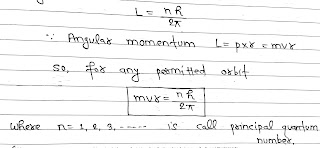Bohr combined classical and early quantum concepts and give his theory in the form of three postulates.
(I) Bohr’s first postulate was that an electron in an atom could revolve in certain stable orbits without the emission of Radiant energy.
According to this postulate, each atom has certain definite stable state in which it can exist and each possible state has a definite Total energy. These are called the stationary states of the atom.
(II) Bohr’s second postulate defines these stable orbits.
This postulate state that the electron revolves around the nucleus only in those orbits for which the angular momentum is some integral multiple of h/2π, where h= Planck’s Constant(h= 6.63×10⁻³⁴j-s).
Thus the angular momentum(L) of the orbiting electron
(III) Bohr’s third postulate state that an electron might make a transition from one of its specified non radiating Orbit to another of lower energy. When it does so, a photon is emitted having energy equal to the energy difference between the initial and final states.

